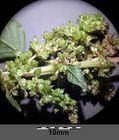Note: This is a project under development. The articles on this wiki are just being initiated and broadly incomplete. You can Help creating new pages.
Amaranthus viridis - Amaranth, Green pigweed
Amaranthus collectively known as amaranth, is a cosmopolitan genus of annual or short-lived perennial plants. Some amaranth species are cultivated as leaf vegetables, pseudocereals, and ornamental plants. Most of the species from Amaranthus are summer annual weeds and are commonly referred to as pigweed. Catkin-like cymes of densely packed flowers grow in summer or autumn.Approximately 60 species are recognized, with inflorescences and foliage ranging from purple and red to green or gold. Members of this genus share many characteristics and uses with members of the closely related genus Celosia.
Contents
Uses
cancer, hair loss, eyesight problem, cardiovascular disease, anemia, perspiration problems, cholesterol, digestion.
Parts Used
Chemical Composition
Principal constituents of this plant are saponins. It is rich in minerals and contains sterols and fatty acids in the seeds. The stem and leaves contain oxalic acid[1]
Common names
| Language | Common name |
|---|---|
| Kannada | Mulluharive soppu |
| Hindi | Kanta chaulai |
| Malayalam | Kattumullenkeera |
| Tamil | mullukkeerai |
| Telugu | mullatotakura |
| Marathi | NA |
| Gujarathi | NA |
| Punjabi | NA |
| Kashmiri | NA |
| Sanskrit | Tanduliuyah |
| English | Needle burr |
Habit
Identification
Leaf
| Kind | Shape | Feature |
|---|---|---|
| Simple | Deltoid | Leaf arrangement is Alternate Spiral, Leaf Bases is Truncate and Leaf Margins are Ent |
.[2]
Flower
| Type | Size | Color and composition | Stamen | More information |
|---|---|---|---|---|
| axillary | 2-4cm long | white–violet | 10-18 | Flowering peaks in December-April and flower are terminal panicles |
Fruit
| Type | Size | Mass | Appearance | Seeds | More information |
|---|---|---|---|---|---|
| Fruits are like An utricle, indehiscent, sub compressed, rugose, brownish | {{{6}}} |
Other features
List of Ayurvedic medicine in which the herb is used
- Vishatinduka Taila as root juice extract
Where to get the saplings
Mode of Propagation
How to plant/cultivate
Prefers a well-drained fertile soil in a sunny position. Requires a hot sheltered position if it is to do well. Plants should not be given inorganic fertilizers, see notes above on toxicity.[3]
Commonly seen growing in areas
Photo Gallery
References
External Links
- Pages that are stubs
- Ayurvedic Herbs known to be helpful to treat cancer
- Ayurvedic Herbs known to be helpful to treat hair loss
- Ayurvedic Herbs known to be helpful to treat eyesight problem
- Ayurvedic Herbs known to be helpful to treat cardiovascular disease
- Ayurvedic Herbs known to be helpful to treat anemia
- Ayurvedic Herbs known to be helpful to treat perspiration problems
- Ayurvedic Herbs known to be helpful to treat cholesterol
- Ayurvedic Herbs known to be helpful to treat digestion
- Herbs with Leaves used in medicine
- Herbs with Seeds used in medicine
- Herbs with common name in Kannada
- Herbs with common name in Hindi
- Herbs with common name in Malayalam
- Herbs with common name in Tamil
- Herbs with common name in Telugu
- Herbs with common name in Sanskrit
- Herbs with common name in English
- Habit - A slender Herb
- Index of Plants which can be propagated by Seeds
- Index of Plants which can be propagated by Cuttings
- Herbs that are commonly seen in the region of Trophical
- Herbs


